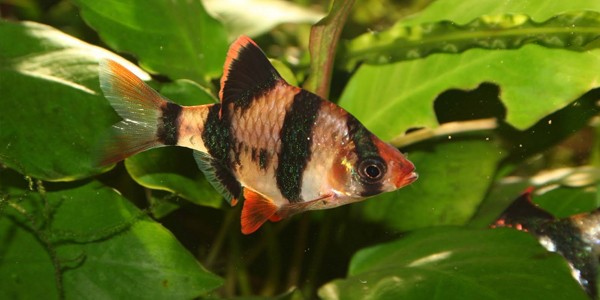Ever wondered having Tigers at your home? Nope! Just kidding...
In this post, we are going to have a quick look about the tiger barbs
To begin with, tiger barbs are freshwater fish that grow maximum up to 3 inches
and can live somewhere between 5-10 years. These are very fun and colorful
types of fish and are perfect for your planted tank. Overall these fish are grey
and have black stripes across the body. A healthy tiger barb has a brighter
color and has red fins.
Behaviors
Generally, these can be a bit aggressive
type of fish, so there is a possibility that they will rip the fins from other
slower fish. So, it is not recommended to keep them in a community tank.
Although if you are thinking to keep them in a community tank, provide many
Tiger barbs in the tank. As they feel better when they are around in the same
species of fish as they are.
But overall these are very playful fish species that will be very fun to
watch.
Diet
Tiger Barbs are omnivorous fish species. You can feed them with almost
anything. It is recommended to give them fish flakes, fish food with veggies.
You can also feed them with pre-packaged food for fish.
If you want to treat them sometimes you can feed them with frozen and
dried foods or live foods, such as Daphnia, Brine Shrimp, and Bloodworms. These
foods will also boost up the protein consumption of Tiger Barb.
Breeding
Breeding the Tiger Barb can have some difficulties. But if you have
decided to breed them you need to take the following actions. Tiger barb love
to eat their eggs, so to avoid that the tank should be filled with plants and
should have a marbled bottom where the eggs will get lost and they won’t be
able to eat the eggs.
To prepare them for breeding, you can take the male fish to keep them in
a different aquarium for up to 5 days. Female Tiger barbs need to be kept in a
large aquarium with a marble bottom. The temperature of the water in the tank
should be 80F degrees. And you need to feed the female fish with a protein full
food and you need to change the 30% of tank water every day.
When you notice a pregnant female fish, you can bring them back to the
breeding tank to keep them with the males. The Pregnant female fish have larger
and rounder belly, while their fins will be darker.
Tiger Barbs lay around a hundred eggs, during this process the males
follow the eggs to fertilize them all. This is when you should try to hide the
eggs from adults.
The fry will grow after a week and will begin to swim after 5 days of
hatching. It is recommended to feed them with all-liquid food or with mashed
brine shrimp.
Tank
Mates
As mentioned above Tiger Barbs aren’t the best fish species to keep in a community tank. But if you will have at least 5-6 Tiger Barbs in one tank they will not be as aggressive as when kept alone in a community tank.
It is not recommended to keep them with fish with long fins or that are
very slow as they will rip their fins off.
You can keep them with fast fish
species, such as Danios, Tetras, and Platys. The majority of Catfish species can be kept with these fish as well.
Tank
requirements for the Tiger Barb
As these are smaller species of fish,
you do not need large tanks to keep a group of Tiger barbs. However, these
are very active fish, who love to swim fast, so they need a space for that. The
minimum tank size should be 30 gallons for
Tiger barbs.
The aquarium for these fish should be heavily planted with a lot of
rocks, driftwood, and ornaments to swim in and out of. Heavily planted
aquariums, as mentioned earlier will provide plenty of space for them to breed
successfully.
The tank temperature of the tank should be between 75 – 80 degrees
Fahrenheit (23 – 27 Celcius) and the hardness level of water should be up to 10
dGH and a pH of between 6 and 7.
Common
Diseases
Tiger Barbs do not have any specific disease but they can have more
usual diseases, for instance, cottonmouth and ich.
The best way to avoid these diseases is to always keep ideal water in the tank, this should be enough to keep your Tiger Barbs healthy. Also, remember that filtration is again one of the main factors to have healthy fish in the tank.
Overall
specifications
- Family: Cyprinidae
- Range: Indonesia, Sumatra, Borneo
- Size: Up to 3 inches
- The temperament of Tiger barb: Semi-aggressive
- Diet of Tiger barb: Omnivore
- Tank Set-up: Freshwater: Rocks, plants,
driftwood
- Tank Conditions: 74-79°F; pH 6.0-7.0; dH 4-10
- Minimum Tank Size: 30 gallons
- Light level: Low
- Care Level: Easy
- Breading of Tiger barb: Egg Layer
In
conclusion
So, what do you think? Are Tiger Barbs right for you? Hopefully, you got
all the information you needed about these fish. Just remember to follow all
the requirements and they will be a great addition to every tank. Don’t forget
to keep them in large groups. If you are looking for playful, fun and fast-moving
fish that will always keep the tank in action, then Tiger Barb will be perfect
for you. And remember that the only way to keep them happy and healthy is to
provide them with the best quality water with good filtration.




Comments
Post a Comment